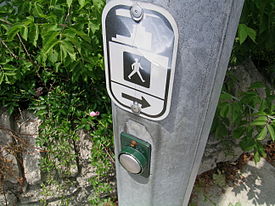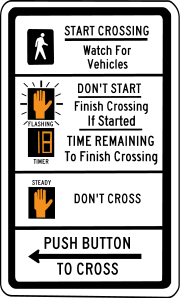- Walk button
-
A crossing button, or intersection crossing button (colloquially referred to as a walk button in the US), is a device typically integrated into modern traffic light configurations, the purpose of which is to allow pedestrians to safely cross a designated portion of a road. They were first introduced in various forms during the 1960s as part of a general push to improve pedestrian safety. Today they are ubiquitous in cities and urban areas across the industrialized world; although their functionally is sometimes disputed.
History
Due to growing frustrations over the ineffectiveness of the traditional Zebra crossing, the early 1960s saw the advent of a number of newly designed systems. The first among them was the Panda crossing, which made its debut in 1962. Despite its inclusion of a rudimentary intersection crossing button, the design’s unwieldy and overly complex system of lights assured its early retirement.[1]
Though the Panda crossing proved a failure, the value of the signal-controlled pedestrian road crossing was nevertheless recognized. The walk button was thus included in a number of other ill-fated crosswalks released during the 60s (Pin Man, X-Way) before being made a standard feature of the Pelican crossing, which was introduced in 1969.[2]
With its refined and comprehensive light configuration, independent walk signals, and innovative incorporation of a fixed crossing time, the Pelican avoided all of the pitfalls of its predecessors while effectively addressing traffic congestion and pedestrian safety.[3] As a result, the design quickly obtained immense popularity in both Britain and the United States, effectively establishing the inclusion of the intersection crossing button in almost all future crosswalk designs.
Use
Intersection crossing buttons typically revolve around a very basic concept: pressing the button eventually forces all cars at said intersection to stop, triggering the walk signal on the opposite side of the road (green person means ‘walk’, red person means ‘don’t walk’). This allows pedestrians to navigate the crosswalk in safety. However, vast differences in the relative sizes of pedestrian populations necessitate the existence of several variations in the popular design.
In the most well-known type, pressing the button when there is no nearby traffic will immediately trigger the walk signal. If there is traffic, it will either allow one to cross at the soonest opportunity or, if sooner, its regular time interval.
The second type, which is often hard to distinguish from the first, only allows crossings at its fixed time interval. Pressing the button typically causes either a time extension for crossing the road or the superficial difference of the words "WALK" or "GO" appearing in place of the green man.
The third, and most deceptive type, does absolutely nothing. It is known as a placebo button. Such buttons were typically functional at one point in time, and were only later disabled due to malfunction, maintenance, or other changes in the traffic configuration. For instance, in New York City, many were deactivated in the late 1980s to prevent interference with the new computer-coordinated signals, although the disconnected mechanisms were left attached to save removal costs.[4]
References
- ^ The Crossings Menagerie - Cambridge Cycling Campaign, Newsletter 71 (April/May 2007)
- ^ Making Roads Safe for Pedestrians or Keeping them Out of the Way? - An Historical Perspective on Pedestrian Policies in Britain, Imperial College London, Centre For Transport Studies
- ^ European Pedestrian Crossings Survey, Pedestrians join zebra crossings as endangered species on UK roads - The Automobile Association, 31 January 2008
- ^ For Exercise in New York Futility, Push Button - The New York Times, 27 February 2004
Categories:- Pedestrian crossing components
Wikimedia Foundation. 2010.


